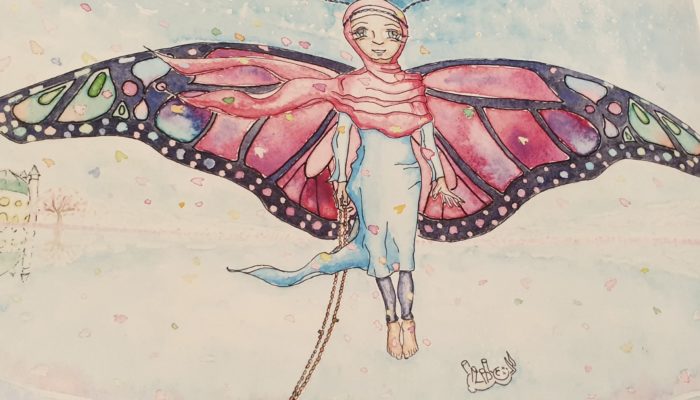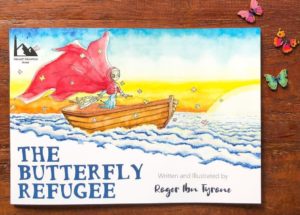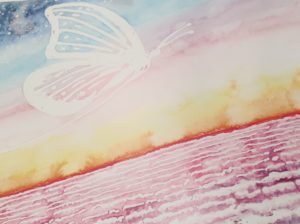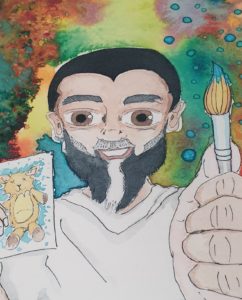Book Review: ‘The Butterfly Refugee’ – Roger Ibn Tyrone
Refugee week (16-22 June, 2019) marks the timely release of the ‘The Butterfly Refugee’, a children’s book and poem written and illustrated by Roger Ibn Tyrone and published by Minaret Mountain Books. The book is recommended for children and adults, aged 8 years and over.
‘The Butterfly Refugee’ offers a poetic narrative of a little girl’s harrowing journey of displacement. The story begins with a reflection of how her life used to be, before she was forced to flee her home country: “I used to have colour in my faith… A bazar full of butterflies and hijab wings, that flap through a welcomed breeze. A loving family that gave me a cute bunny, just for me to squeeze. Then the colourless ones came, like moths in the night… They wage war, where all the colours of faith are drained.” The story’s characteristic symbolism and use of butterfly metaphors are evident here, creating a strong juxtaposition between the little girl’s former, ‘colourful’ life (punctuated by ‘welcome’ and freedom, which was framed as the ability to fly) and the war that saw her freedom and sense of welcome taken away:
“Butterflies were fading and not many flying around. They lay black and white flightless, colourless upon the ground.”
The little girl then recounts the tragic death of her father, following which she was briefly reunited with her mother before facing the devastating choice to leave her now destroyed home: “We had to run suddenly, to where I don’t know”, an experience she can only describe as “colourless butterflies flightless, wings tangled and battered. Their dreams of flying, like exploding glass, now shattered”. Here, we see the use of war imagery creatively applied to the little girl’s description of the war’s effects on the people forced to flee her homeland.
The story then moves onto her perilous journey by sea to find a new place to call home. During this time, the little girl notes that she “prayed to Al-Hafiz, seeing sea horizons for days. Then a picture of land was drawn, at early dawn displayed.”
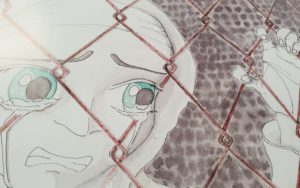 Upon arriving at her destination, she despairs at how she was “treated so colourless” and “sent to a cage” – the cage representing Australia’s detention regime, whereby the little girl in the story describes hunger strikes, protest, confinement, and her dismay at seeing others turned away and denied their rights to safety:
Upon arriving at her destination, she despairs at how she was “treated so colourless” and “sent to a cage” – the cage representing Australia’s detention regime, whereby the little girl in the story describes hunger strikes, protest, confinement, and her dismay at seeing others turned away and denied their rights to safety:
“I’m a child behind barbed wire fences, my time here seems so endless. My only crime was staying alive, and for that, I was sentenced.”
Following her experiences of detention, the little girl recounts the conflicted feelings of joy and sadness she felt the day she was claimed by a family member she never knew she had: “a warm embrace, a squeezy hug, reminiscent of my dad. He smelled of rose musk like Papa, the scene made me so sad.” This part of the story is positioned as a period of transition, during which the little girl is a caterpillar “earing knowledge leaves from wise trees”. At this stage she alludes to the harsh impact of racism that permeates Australia’s national conversation about people seeking asylum: “the angry moths here, tell me to go back home. I didn’t understand why they hated me to the bone.”
The little girl then speaks of her cocoon – she depicts this as a period of growth whereby she encounters “those with human colour” who make her feel like she can “call this place home”.
The little girl then speaks of her cocoon – she depicts this as a period of growth whereby she encounters “those with human colour” who make her feel like she can “call this place home”. The story ends with her coming to terms with the fact that, along with her father, she has also lost her mother whom she heartfully tells “I love you, your wings in my heart forever will fly”. To her father, she says “Papa I love you. Look I’m colourful just like Mumma butterfly” – these words of love, heartbreak and acceptance conclude the little girl’s story, marking her evolution into a “butterfly refugee”.
This book is a beautiful and moving representation of just one of the many journeys experienced by children seeking a chance at a better life. It is a touching and thought-provoking story, with Tyrone’s gorgeous watercolour illustrations painting a vivid picture of the story’s strong, underlying theme of hope and resilience. I hope that our Refugee Research Online community, along with my friends and family, will consider buying this book – both for themselves and the young ones in their lives.
I hope my pictures paint my words and my words paint pictures.
Author and illustrator, Roger Ibn Tyrone, is based in Sydney, Australia. He writes and illustrates Islamic children’s books with Minaret Mountain Books, all of which feature underlying themes of positive teaching. I was lucky enough to have the opportunity to speak with Roger, who kindly agreed to answer some questions about the book.
Ashleigh: Firstly, thank you for creating and sharing such an inspiring story and work of art.
On the first page, you have included a touching dedication to your daughter, Qeeda, whom you have likened to a beautiful butterfly and described as making your life more colourful. And on the final page, you noted that while researching for the book, you were able to relate your own experiences with your family to some of the suffering experienced by refugees. Would you say that Qeeda served as your inspiration for the little girl in the story?
Roger: The inspiration for the little girl is a combination of refugee girls I’ve had the honour of teaching. Some of that showed an awe-inspiring strength and determination despite what they had been through. I remember a girl trying to hold it together as she explained that she and her family might be sent back to their country. I wanted the butterfly refugee to reflect strength, her breaking point and how she picks herself up again.
I will always remember when my father told me that when I have a child then I would understand how he truly feels. When my first daughter was born the colour of unconditional love and realisation of all one’s parents have done for them, flowed into my heart. It’s a life changing moment, a new journey of self-betterment. My daughter is all the things I’ve said about her in the dedication, this strength is within all girls.
As to relating to the refugee experience that comes from my family’s journey to Australia. I escaped from the ‘83 Sri Lankan riots – ‘Black July’ they now call it – which eventually lead to a civil war that spanned nearly 3 decades. An angry mob was outside our house with machetes. I was with a family member barricading the toilet door with a mattress and an uncle turned off the front lights and made it seem he was attacking them. They panicked and ran to the next house and we managed to escape out the back. Many people including babies were burnt alive, I want anyone reading this to reflect on that for a moment …
What narratives would it take to insinuate a whole nation to the point where they commit such violent acts? … Picking up a baby and throwing it on a fire with the belief that that was the right thing to do? Divine intervention prevented me aged 3 at the time from the same fate. I can’t express my disdain for extreme mentalities on any side and the grotesque repercussions that it may bring. Extremist rhetoric speaks words powerful enough to drive whole nations insane. The after effects are dealing with a lifetime of trauma that is hard to express.
I hope my pictures paint my words and my words paint pictures. I draw on personal experiences of racism and discrimination and feeling like you didn’t belong in any country. I draw on my life and others I’ve come into contact with similar yet different contexts. I’m hoping to give kids some inspiration to know when they need to change the narrative for the good of humanity and I believe it starts with putting compassion in their hearts.
Ashleigh: What other things have inspired your art, and how long have you been illustrating and writing poetry?
Roger: Inspiration can come from anywhere – seems to hit me from nowhere for the most part. I was taking a mountain walk to give me a break from painting our book ‘It’s Jummah Day’. I’m always amazed at the colours and scenery. As I looked out in the Blue Mountains on my walk, I was thinking about its colours and it reminded me of an old documentary I saw as a kid, before I was Muslim, talking about Islam in a very negative light. I believe they called it a ‘dark cold colourless religion’. They had black and white images of Islam and scary music in the background to prove their point. I remember it scared me as a child and I think that’s why Islam was the last religion I looked into and studied because of such negative media. I remembered they took colour away as a way of demonising the Muslims.
On my walk I thought it wasn’t the religion or the text, but more like people that stripped away its vibrant colour and showed a black and white portrayal of what the religion actually is. There are finer nuances and a world of meaning within the text but people turn the colours of greater understanding into misinterpreted, literal, black and white. And then the whole story of ‘The Butterfly Refugee’ roughly came into my head. I also wanted to do it as I wanted to experiment more with my art to loosen me up as I felt the art I was doing was stagnant and to clinical. I decided to paint the images I had in my mind without holding back and that’s what you see in ‘The Butterfly Refugee’.
I started drawing as a child. I remember it meant so much to me for some reason. There was a car I had drawn on a Friday at primary school. It was a red hodgepodge of a Ferrari – Porsche mix. I would dream about it all weekend and couldn’t wait to finish it on Monday. The thing was I never saw myself as an artist but when I drew, people would comment. My older brother then got into music and I followed suit which lead to a period of my life that’s all too much to explain here. I continued to draw here and there teaching myself. Many years later my wife was searching for an illustrator for her book ‘It’s Jummah Day’. I was never happy at the price illustrators were charging or their quality of work. She eventually gave me an ultimatum of 2 months. I had to come up with something or she’d choose one. I applied everything I had learned from the music discipline and applied it to learning art.
I had been writing poetry and songs ever since I had been into music. My dad was a guitar player and so was my brother and there was a heavy musical influence within the family. When I got into hip hop I would say I studied rap as I seem to delve deeply into any subject I get into. I’ve written boxes, literally boxes, of raps or free form poetry since then. I continued writing poetry and found it cathartic. It helps me to dispel anger and pent up emotion about the world’s situation that I feel helpless to change.
Ashleigh: What is the key message that you want people to take away from this story?
Roger: My wife and I like the idea of leaving it up to the reader, as we like hearing the different interpretations of the text and illustrations from our readers. I feel like each page has its own meaning and each illustration says the things I can’t put into words. There are deep issues I’ve added in the illustrations if you look closely enough. The story does span the little girl’s life till she becomes wise. She then passes on her colour from her heart on to the reader, the reader passes it on to the listener and so on. I did however want the book to share my feelings of hope. Keep waiting. Keep moving forward, always forward. It’s not easy. In the difficulties there will be a beauty to behold. Just hold on till that next corner. You are waiting to find out your own story. You don’t know the ending till you keep reading. Keep reading. Read.
Ashleigh: I’m very much looking forward to engaging with more of your work in this space. Are you planning on releasing more stories, artwork and/or other projects that engage with similar themes in the future?
Roger: I was saying before that I use the way I wrote music to write books, so not every song will be intense. You need to know when to hold back. A good album is diverse, sending its listener on a journey through the soul and heart of the composer. I want to do the same but not every book I write will be as deep and intense as ‘The Butterfly Refugee’. It may have similar themes but I may delve into them a little differently.
My wife and I have been sent many messages talking about how people have cried over ‘The Butterfly Refugee’. In one case a lady had read it and broke down into tears. My wife had to keep handing her tissues. I never imagined it would have this impact, although to me it was special I didn’t know if anyone else would feel the same as art and expression is subjective. But the book is effecting hearts. It is great catalyst for conversation and may inspire reaction for action, hopefully.
My newest book ‘Daris the Bosniak’ is a tale of adventure love and brotherhood, but it has an underlying message of my admiration and respect of the Bosnian people, their strength and courage to rebuild their lives after the genocide in 1993. It was my way to say that they are heroes to me. As they battle grief, loss, extreme depression, psychological damage and cultural hardship, I represent with them battling giants in the story. I also use my artwork to express the beauty of Bosnia. I want to create awareness to try and do my part to make sure that such an event never happens again. I can only pray and hope as there is still tension in the area. Even though the book is meant to be a fun read for kids, I hope they can research on their own about Bosnia and a world community can stand united against any future aggression against such a beautiful country.
I will always continue to teach through a creative medium as I believe children learn from stories and lessons contained within rather than throwing facts and figures at them. It also opens the creative part of the brain that will help them be better thinkers and thus more opportunities and solutions for our future. At least, that is what I would like to believe. I know for myself certain books and morals have stuck with me until know and change the way I think or propel me to action. I’m grateful for any little change or spark I’m able to cause within my readers hearts.
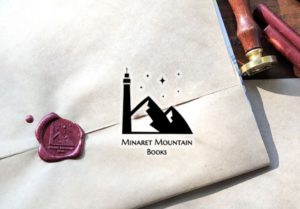 ‘The Butterfly Refugee’ and Roger’s prior works can be found and purchased online.
‘The Butterfly Refugee’ and Roger’s prior works can be found and purchased online.
Minaret Mountain Books is also on Facebook and Instagram: @minaretmountain.books.
